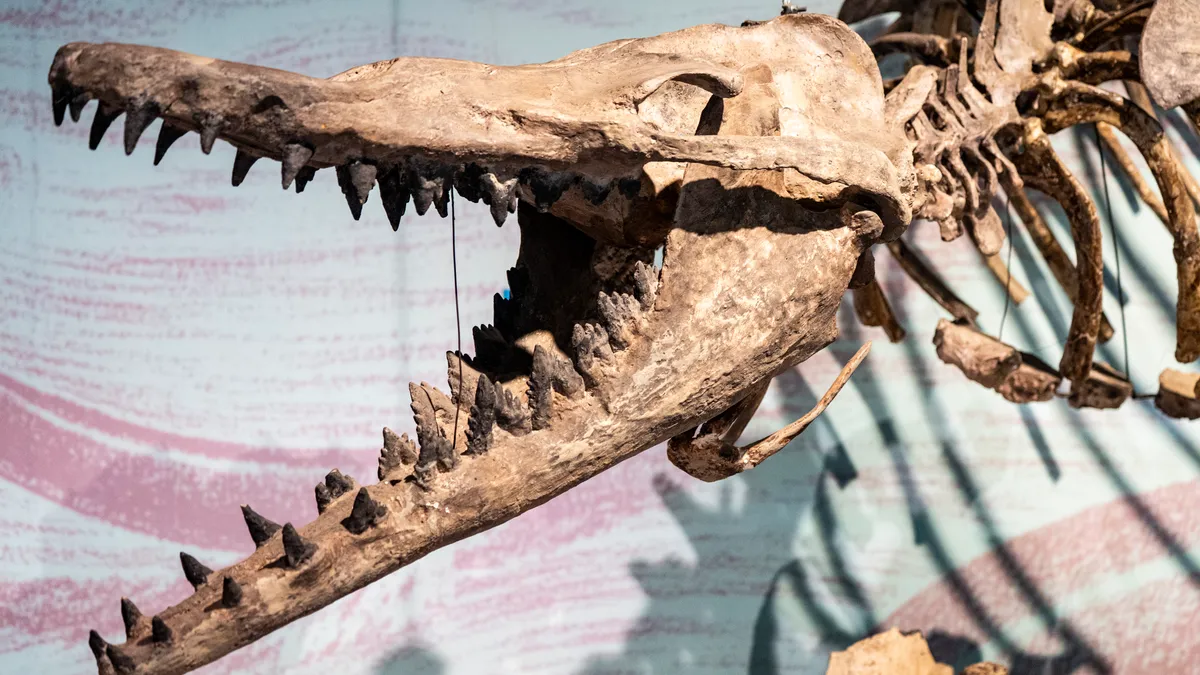Copyright Jackson Clarion-Ledger

A fossilized rib from a ferocious, extinct whale was discovered in a creek bank in Yazoo County, Mississippi. The rib belonged to a zygorhiza, a toothed whale that lived 34 to 38 million years ago and grew up to 18 feet long. Whale fossils are found in Mississippi because the area was once submerged under an ancient arm of the Gulf of Mexico. Zygorhizas were fearsome predators with serrated teeth for tearing apart prey, unlike modern dolphins. It was just a small piece of bone sticking out of the bank of a creek. After digging it up, it turned out to be a fossilized rib from a ferocious whale that once called Mississippi home, but suddenly went extinct 34 million years ago. "I was just walking along and saw it sticking out of the bank," said Robbie Ellwanger, a fish and mussel biologist with the Mississippi Museum of Natural Science. "I saw a piece of it sticking out of the bank and started digging, and it just kept going." Ellwanger was in Yazoo County, an area known for producing fossils, along with other scientists doing field work in late October. Although he didn't know what type of animal it came from, he knew it was a rib. "It was cool," Ellwanger said. "I haven't found a full rib like that before, so it was cool. It's always exciting when we find any kind of fossilized material." As exciting as it was, more looking around didn't reveal more bones from the animal, which was a bit of a let-down for Ellwanger. "Unfortunately, it was probably disarticulated long, long ago," Ellwanger said. "So, the rest of the animal wasn't with it." Rib from ferocious zygorhiza, found in Mississippi. What's a zygorhiza? Ellwanger didn't know which animal the rib came from, but he didn't have to search very long to find someone who did. George Phillips, the museum's paleontologist, was among the scientists and quickly identified it as belonging to a zygorhiza. According to Phillips, these whales lived late in the Eocene Epoch, about 38 million to 34 million years ago. Adults grew to lengths of 15 to 18 feet and weighed in the neighborhood of 5,000-7,000 pounds. They belong to an extinct group of toothed whales called basilosaurids, or zeuglodonts. But why was a whale bone found in Yazoo County, roughly 200 miles from the nearest salt water? "What we know today as the Mississippi River Valley was at one time inundated by the Gulf of Mexico, as early as 90 million years ago," Phillips said. "Over time, this arm of the Gulf retreated southward in a stepwise fashion to the current coastline along the Louisiana shore. When zygorhiza was swimming in this sea, which we refer to as the Jackson Sea for that specific interval, the shoreline would have been somewhere between Clarksdale and Memphis." Zygorhizas were fearsome predators of the ancient seas At up to 18-feet long and weighing over 5,000 pounds, zygorhizas were large predators, but their cousins were even bigger. According to James Starnes, associate state geologist with the Mississippi Department of Environmental Quality Office of Geology, the cynthiacetus maxwelli grew to 30-feet long. The basilosaurus was even larger. Starnes said it grew to about 70 feet in length. Despite being the smallest of the three, Starnes said it was a force to be reckoned with. "These things were probably much faster than their larger cousins and much more agile than their larger cousins," Starnes said. "These were not cute little dolphins out there. These were quite ferocious animals." Starnes said the dolphins on the coast we're accustomed to, along with other toothed whales such as orcas, have peg-like teeth made for grabbing prey and positioning it in their mouths to swallow whole. Zygorhizas had similar teeth in the front, but other teeth were shaped like arrowheads and had large serrations for tearing prey apart. That allowed them to eat larger prey in relation to their body size than modern toothed whales. The size of zygorizas, their speed, agility and teeth made them frightening predators and if they hunted in packs like dolphins and orcas they would have been truly nightmarish. "Just running into one of those would be one thing, but running into a pack would be a whole other world," Starnes said. Why did zygorhiza become extinct? Zygorhizas and their cousins had a good run. They were around for several million years, but all good things come to an end. There doesn't seem to be a clear explanation why they became extinct, but like today, the climate was changing except back then it was getting cooler. Phillips said that ice sheets formed on the poles about that time. Prior to that, there were no polar ice caps. "This affected continental climate and global circulation, although continental drift affects both, so the changing distribution of the continents may be the ultimate culprit," Phillips said. Whatever the reason was, their extinction appears to have come quickly. "At the end of the Eocene, these things are gone," Starnes said. "In the blink of an eye, they were gone." Do you have a story idea? Contact Brian Broom at 601-961-7225 or bbroom@gannett.com.



